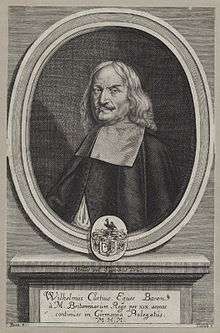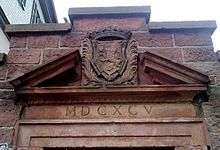Curtius baronets

The Curtius Baronetcy of Sweden was a title in the Baronetage of England,[1] created on 2 April 1652 for William Curtius, "Resident to the King of Sweden".[2]
Curtius was a diplomat representing the House of Stuart during the Thirty Years' War and the exile of Charles II, and head magistrate for two of the Electoral Palatinate districts for many years. [3] [4] Curtius was elected as a Fellow of the Royal Society in 1667,[5] and was England's Resident Ambassador to the Holy Roman Empire from 1664 until 1677.
The second baronet was Karl Wilhelm (Charles William); his son Carl August Adolf von Curti was the third.
The baronetcy became extinct in 1823 with the death of the fourth baronet, Wilhelm Adam. The Curti-Schloss was inherited by Julianne von Curti, and then by her children of her marriage into the Von Gall family.
English diplomat
William Curtius served as secretary to King Charles I's Calvinist brother-in-law, Frederick V, Elector Palatine,[6] up until the Elector's death in November 1632.
In 1632, in the midst of the Thirty Years' War, Curtius went to the Swedish King campaigning in Germany as Secretary to the English ambassador Sir Henry Vane.[7] Curtius then remained in Germany as an Agent of Charles I of England until December 1633.[8]
Curtis then entered the Palatine Service[9] until Charles I appointed him as representative of England at the Imperial Diet of Nürnberg in 1639 and 1649, and at Frankfurt in 1642. He also supported Sir Thomas Roe in Vienna in 1641-42.[8]
Curtius was appointed by Charles I as official resident of the English Crown in the Holy Roman Empire. In 1652, the time of his appointment to the Baronetcy by the then-exiled Charles II, Curtius was "resident for his majesty, with Gustavus, King of Sweden, and the princes of Germany".[1] Charles II described him as "borne in these partes, and long imployed there by our father of blessed memory" [10]
On 5 August 1664, four years after Charles II's Restoration, Sir William was appointed Resident Ambassador at Frankfurt am Main, and remained so until recredentialled in September 1677.[1][8]
German governor
Curtis was appointed Oberamtmann - Bailiff, or District Governor - for the Electoral Palatinate in the city of Umstadt from 1650 to 1672, his son Charles William again from 1681 to 1691. At that time, half the city was owned by the Palatinate as a condominium with the changing successors of the Landgraviate of Hesse: the Landgraviate of Hesse-Darmstadt, Landgraviate of Hesse-Kassel and Hesse-Rheinfels.[3]
Fellow of the Royal Society
Sir William was elected as a Fellow of the Royal Society on 3 October 1667.[5][11] He corresponded with both Henry Oldenburg, the Secretary of the Society, and Leibniz, bringing the latter a copy of Wilkin's Encyclopaedic Essay.[12]
Curtius Baronets, of Sweden

- William Curtius FRS, 1st Baronet (Born Johann Wilhelm di Curti on 12 August 1599 in Bensheim, died 23 January 1678 in Frankfurt am Main).[4][13]
- Charles (William) Curtius, 2nd Baronet (26 December 1654 – 13 April or September 1733)[13]
- Herman Carl (Charles) August Adolf Curtius, 3rd Baronet (22 April 1699, married 15 March 1740, 18. August 1753)[14]
- Wilhelm Adam von Curti, 4th Baronet (21 July 1742 - 15 January 1823).[13]
On his death in 1678, Sir William was succeeded as Baronet by his son, Sir Charles William Curtius (Carl von Curti), who lived until 1733. Sir Carl was also appointed as Oberamtmann of Umstadt, from 1681 to 1691.
Sir Charles petitioned the English Parliament to pay the substantial fees promised Sir William by "Kings Charles the First, and Second". The petition sought "for a Debt incurred upon the Account of Publick Service by his Father Sir Wm. Curtius, that to the Amount of Fourteen thousand Two hundred Fifty-five Pounds, as appears by the Accompt signed by his late Majesty King Charles the Second; who was pleased to grant him a Privy Seal for Two thousand Pounds; but only Five hundred Pounds, Part thereof, was paid." [16] The petition was unsuccessful.
Since 1785, the church in the village of Wald-Amorbach, Breuberg has rung its bells at 10am daily in the "Curti-Peal" for the salvation of the von Curti family. The peal was established by Carl August Adolf von Curti's widow, Erhardine Catharina Louise von Wahl (* around 1700, † 17. Februar 1786), when she gave the Curti forest to Gross-Umstadt.[14]
Wilhelm Adam von Curti was declared bankrupt in 1790. His estate at that time included feudal leases ("lehen") in six towns: Groß-Karben, Klein-Karben, Kaichen, Kloppenheim, Burggräfenrode and Dortelweil, Kurpfalz.[17]
The baronetcy became extinct in 1823 with the death of Wilhelm Adam, the last male descendant.
| Baronetage of England | ||
|---|---|---|
| Preceded by New creation |
Curtius Baronetcy, of Sweden 1652–1678 |
Succeeded by Sir Carl William Curtius |
References
- 1 2 3 Heyleyn, Peter (1773), Help to English History: Containing a Succession of All the Kings of England ... the Kings and Princes of Wales; the Kings and Lords of Man: and the Isle of Wight. As Also of All the Dukes, Marquises, Earls and Bishops Thereof ... Together with the Names and Ranks of the Viscounts, Barons, and Baronets, of England, p. 475
- ↑ Cokayne, George E. (1900), Complete Baronetage, Exeter: W. Pollard & co., ltd.
- 1 2 Widder, Johann Goswin (1 January 1787). Versuch einer vollständigen geographisch-historischen Beschreibung der kurfürstl. Pfalz am Rheine. Band 2. (A geographic history of the Palatine Electorate, volume 2). Frankfurt und Leipzig: Dritter Zheil. p. 4. Retrieved 25 August 2015.
- 1 2 Wilhelm von Curti, Biography of Hesse, at: Landesgeschichtliches Informationssystem Hessen (LAGIS) in Germany
- 1 2 "Fellowship of the Royal Society".
- ↑ Oman, Carola (1938), Elizabeth of Bohemia, London: Hodder and Stoughton Limited, pp. 325, 369
- ↑ Collins, Arthur (1812), Peerage of England, England: F. C. and J. Rivington, p. 509
- 1 2 3 Bell, Gary M. (1995), Handlist of British Diplomatic Representatives, 1509–1688, Cambridge: Cambridge University Press, pp. 146, 274
- ↑ Queen Elizabeth (Consort of Frederick King of Bohemia) (2011), Akkerman, Nadine, ed., The Correspondence of Elizabeth Stuart, Queen of Bohemia, Oxford: Oxford University Press, p. 274
- ↑ Calendar of the Clarendon State Papers Preserved in the Bodleian Library 1649-1657, ed. by the Rev. W. Dunn Macray. Great Britain: Clarendon press. 1869. p. 166.
- ↑ Thomson, Thomas (1812). History of the Royal Society, from Its Institution to the End of the 18Th Century. London: Baldwin. p. xxv, Appendix IV.
- ↑ Maat, Jaap (2012). Philosophical Languages in the Seventeenth Century: Dalgarno, Wilkins, Leibniz. Springer Science & Business Media. p. 298.
- 1 2 3 Curti Castle (de)
- 1 2 "Stadtarchiv Breuberg: Curti-Waldkauf-Originalurkunde von 1785 entdeckt".
- ↑ The Standing Council of the Baronetage. "A short history".
- ↑ "House of Commons Journal Volume 10: 3 August 1689". Journal of the House of Commons. 10 (1688–1693): 251–252. 1802.
- ↑ "Leonhardi, Johann Peter Freiherr von, in: Hessische Biografie". 10 Sep 2013.